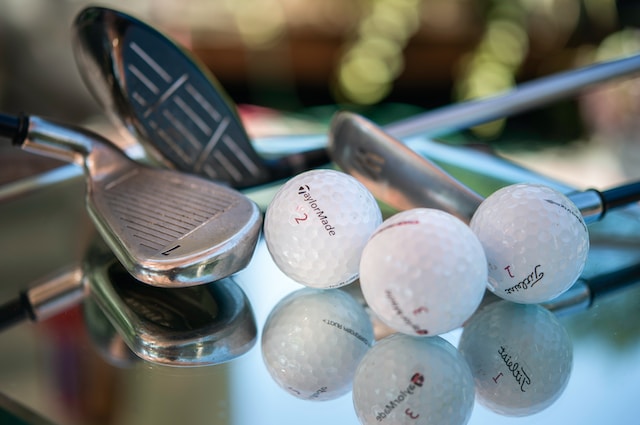Golf, often described as a game of precision and finesse, demands more than just skill and technique from players. Every element of a golfer’s equipment, from the clubs to the golf balls, plays a pivotal role in shaping the outcome of a round. Among these, the humble golf ball, a small but crucial component of the game, can significantly influence a player’s performance. In this exploration of golf balls, we’ll delve into the various facets of these dimpled orbs. We’ll address questions such as: How do we go about choosing the right golf ball? How can one discern the quality of a golf ball? What factors dictate the selection of a golf ball based on swing speed? Which golf balls are designed to soar the farthest? And for those with a keen interest in the professional circuit, what golf ball does Tiger Woods favor?
How do I choose the best golf balls?
Selecting the best golf ball is akin to an artist choosing the ideal brush for a masterpiece. It’s an integral tool in our golfing arsenal, influencing each stroke and every putt. But how does one navigate the maze of options to find the ideal golf ball?
Evaluating Your Skill Level
Begin with a critical self-assessment of your golfing prowess. Golf balls come in an array of models tailored to different skill sets. For novices, a softer, low-compression golf ball can be a boon. These balls are more forgiving, imparting better distance and control, even on off-center strikes. On the flip side, seasoned players with a consistent swing might prefer high-compression golf balls, offering enhanced control and spin.
Budget Considerations
Your budget plays a pivotal role in your selection. While certain golf balls boast cutting-edge technology and remarkable performance, they may come at a premium price. Thankfully, the market offers options across various price ranges, ensuring you can find a ball that aligns with your budget without compromising quality.
Factor in Playing Conditions
The golf courses you frequent and the climatic conditions you encounter significantly influence your choice of golf ball. Courses with plush, soft fairways benefit from balls featuring softer covers that generate more spin and control. Conversely, firmer courses necessitate balls with harder covers for enhanced distance and durability. Climate plays its part too; on sweltering days, a softer ball might compress excessively, altering your shots, while a firmer one can ensure consistency.
Personal Preference
Ultimately, personal preference looms large in the golf ball selection process. Some players relish the soft feel of the clubface, while others savor the crisp feedback of a firmer ball. The best approach is to experiment with various balls to find one that harmonizes with your playing style and preferences.
How can you tell if a golf ball is good quality?
The quality of a golf ball is an elemental factor in your game. An inferior ball can yield inconsistent results, frustration, and missed opportunities. So, how can you discern the quality of a golf ball?
Brand Reputation
A straightforward indicator of a golf ball’s quality is the reputation of the brand behind it. Esteemed golf ball manufacturers such as Titleist, Callaway, TaylorMade, and Bridgestone have meticulously built their repute through years of research, development, and innovation. These brands are renowned for crafting top-tier golf balls catering to players of all levels.
Scrutinize Manufacturing Consistency
Quality golf balls are characterized by precision manufacturing, where consistency reigns supreme. Scrutinize the ball’s surface for blemishes, irregularities, or defects. A well-crafted golf ball should sport a uniform dimple pattern and a seamless cover. Any deviations can impede the ball’s flight and performance.
Compression Rating
The compression rating is another pivotal aspect of golf ball quality. Golf balls typically come with a compression rating, as indicated on the packaging. Lower compression balls are softer and favor golfers with slower swing speeds, offering enhanced distance and forgiveness. Conversely, higher compression balls are firmer and ideal for those with faster swing speeds who seek control and spin.
Durability Assessment
The durability of a golf ball contributes to its quality. Premium balls are designed to withstand the rigors of the golf course, including encounters with trees, bunkers, and cart paths. If a ball succumbs to scuffs or cuts easily, it may not meet the criteria for quality and could negatively impact your game.
Reviews and Recommendations
Before making a purchase, it’s prudent to peruse reviews and seek recommendations from fellow golfers. Online reviews and feedback from players who have used the ball can furnish valuable insights into its performance and quality. Additionally, consulting with golf professionals or trusted golf shops can facilitate an informed decision.
In the professional realm of golf, we recognize that the golf ball is far more than a mere sphere; it’s an instrument that can make or mar our performance. Thus, dedicating time to ensure that our chosen golf balls uphold the highest standards is a stride toward achieving peak performance on the fairways.
In the second half of this exploration, we’ll delve into the selection of golf balls based on swing speed, identify balls primed for maximum distance, and unveil the golf ball that has found favor with the legendary Tiger Woods.
How do I choose a golf ball for swing speed?
Choosing the appropriate golf ball tailored to your swing speed stands as a pivotal step toward optimizing your performance on the golf course. The interplay between swing speed and the chosen golf ball wields substantial influence over distance, control, and overall playability. How does one navigate this intricate decision-making process?
Deciphering the Swing Speed-Compression Nexus
The compression rating of a golf ball is a critical determinant when selecting a ball attuned to your swing speed. Compression signifies the degree of compression the ball undergoes upon impact with the clubface. It’s typically expressed as a numerical figure on the golf ball packaging, such as 70, 80, or 90.
For Slower Swing Speeds: Low Compression
If your swing speed lingers below 90 miles per hour, low-compression golf balls are your go-to choice. These balls are designed to compress more readily, culminating in higher ball speed and extended distance. They also tend to generate more spin, bestowing greater control, particularly around the greens. Golfers with slower swings often relish the added forgiveness and distance that low-compression balls offer.
For Moderate Swing Speeds: Mid-Compression
Moderate swing speeds, typically within the 90 to 105 miles per hour range, beckon the consideration of mid-compression golf balls. These balls strike a balance, providing a harmonious blend of distance and control. Engineered to deliver substantial compression without relinquishing feel and control, mid-compression balls are versatile choices that cater to a broad spectrum of players.
For Faster Swing Speeds: High Compression
Golfers wielding faster swing speeds, surpassing 105 miles per hour, gravitate toward high-compression golf balls. These balls boast firmness, resisting excessive compression upon impact. Consequently, they offer exceptional ball speed and distance, a boon for players reliant on their swing speed to generate power. High-compression balls also find favor among professional golfers who demand unrivaled control and precision.
Beyond Compression: Fine-Tuning Your Selection
Beyond compression, other factors deserve consideration when zeroing in on the best golf balls for your swing speed. Dimple design, cover material, and core construction all exercise influence over the ball’s flight and overall performance. Here are additional insights to guide your selection:
Dimple Design: Delving into dimple design unveils another layer of complexity. The dimple pattern etched on a golf ball influences its aerodynamics. Balls adorned with varying dimple designs produce different levels of lift and drag. Shallow dimples, for instance, tend to promote more lift, aiding golfers with slower swing speeds by prolonging the ball’s airborne time and providing added carry distance. Conversely, deeper dimples reduce lift, ushering in more roll, an appealing prospect for those with faster swing speeds looking to maximize distance off the tee.
Cover Material: The cover of a golf ball can either be constructed from urethane or ionomer. Urethane covers lean toward softness and furnish ample spin and control around the greens, rendering them the preferred choice of skilled golfers across all swing speeds. Ionomer covers offer increased firmness, equipping them with added durability and distance, making them fitting for golfers seeking extended distance off the tee.
Core Construction: The heart of a golf ball, its core, fluctuates in size and composition. Larger cores, combined with a higher compression rating, translate into greater ball speed—a boon for golfers with faster swing speeds. However, it’s essential to bear in mind that a larger core may reduce spin, potentially impacting your short-game control.
Testing and Experimentation: The ultimate litmus test for selecting the perfect golf ball tailored to your swing speed is embarking on a journey of testing and experimentation. Seek out golf shops or driving ranges that offer ball-fitting services. Here, you can sample an array of ball models, subjecting them to your swing speed’s scrutiny. Pay heed to factors such as distance, accuracy, and feel to pinpoint the ball that harmonizes optimally with your game.
In the world of professional golf, each adjustment, no matter how seemingly minor, could spell the difference between success and mediocrity. The choice of a golf ball hinging on swing speed is one such critical modification that can pave the path to enhanced performance and lower scores. By acquainting yourself with the intricate dance between swing speed and compression, you empower yourself to make a judicious selection.
Which golf balls are best for distance?
For golfers, the quest to maximize distance off the tee is an ever-present ambition. Achieving substantial distance can significantly alter the outcome of your game, especially when confronted with lengthy par-4s and par-5s. So, which golf balls are engineered to soar to unparalleled distances?
Low Spin for Distance Maximization
One of the primary contributors to distance is spin—or more precisely, the lack thereof. Golf balls designed for maximum distance emphasize low spin characteristics. These balls strive to diminish backspin, which, in turn, reduces drag and lift during flight, resulting in longer, more penetrating trajectories. Golf balls engineered to traverse great distances typically incorporate a firmer core and cover to achieve this low spin phenomenon.
Surlyn Covers for Endurance
Many golf balls optimized for distance boast Surlyn covers, a robust material that fortifies the ball, ensuring it retains its structural integrity and flight attributes even after repeated use. Surlyn covers are notably resilient against scuffs and damage, making them a favored choice for golfers who frequently launch formidable drives.
Multi-Layer Complexity
Multi-layer golf balls further unravel the intricacies of distance optimization. These balls, often featuring a larger core, multiple mantle layers, and a durable cover, target distance enhancement. They leverage the core’s compression to unleash impressive initial ball speeds while preserving low spin for extensive distance.
Distance Marvels in the Market
A slew of golf ball models have garnered acclaim for their exceptional distance capabilities. Leading brands such as Callaway, TaylorMade, and Titleist offer distance-centric golf balls tailored to diverse swing speeds and player preferences. Noteworthy distance golf balls include the Callaway Chrome Soft X, TaylorMade TP5x, and Titleist Velocity.
It’s crucial to note that while distance-centric golf balls can help you conquer impressive drives, they may concede some measure of control and feel, especially around the greens. Golfers should strive for a balance between distance and control in accordance with their playing style and predilections.
What golf ball does Tiger Woods use?
In the world of professional golf, the choice of the best golf ball is not just a matter of preference; it’s a carefully calculated decision that can make or break a player’s performance. Even the legendary Tiger Woods is not immune to the profound impact that the choice of a golf ball can have on his game.
Throughout his illustrious career, Tiger Woods has been closely associated with Nike Golf, a brand that manufactures golf balls under the Nike label. However, in 2016, Nike made the surprising announcement of its exit from the golf equipment market, leaving Tiger Woods in search of a new golf ball.
Tiger Woods eventually transitioned to playing Bridgestone golf balls. Specifically, he adopted the Bridgestone Tour B XS, a ball celebrated for its impeccable control and spin around the greens while still delivering the distance and ball speed demanded off the tee. The Tour B XS boasts a urethane cover and a dual-dimple design, both contributing to its remarkable performance attributes.
Tiger Woods’ shift to Bridgestone was not a capricious decision but rather a result of extensive testing and a quest to find a golf ball that seamlessly integrated with his game at the highest echelon of professional golf. His collaboration with Bridgestone enabled him to have a golf ball customized to his precise specifications, ensuring it met his unique requirements for distance, control, and feel.
In conclusion, the selection of the best golf balls is a decision of paramount importance, both for professional golfers and enthusiasts. It demands contemplation of factors such as skill level, swing speed, and playing conditions. Equally critical is ensuring that the chosen golf ball meets the stringent criteria for quality, as it is an element that directly shapes the outcome of your game. For those seeking to attain unparalleled distance, low-spin golf balls with robust Surlyn cover and intricate multi-layer constructions stand as the go-to choice. And for those intrigued by the professional realm, Tiger Woods, the epitome of golfing greatness, has found his golf ball ally in the Bridgestone Tour B XS, a testament to the weighty significance of the right golf ball in a golfer’s arsenal.







